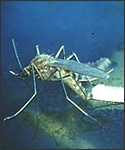Japanese Encephalitis Photos
One of the Non-routine Vaccines by Disease
WARNING: Some of these photos might be unsuitable for children. Viewing discretion is advised.
Photos of the Disease
West Nile Virus (WNV) is a member of the Japanese encephalitis virus antigenic complex, which includes several medically important viruses associated with human encephalitis: Japanese encephalitis, St. Louis encephalitis, Murray Valley encephalitis, and Kunjin, an Australian subtype of WNV.
A few samples from the Public Health Image Library

Photo ID# 12793
Using a histochemical technique in processing this tissue specimen, this image reveals the presence of the West Nile virus.

Photo ID# 12792
This photomicrograph revealed some of the histopathologic changes in this specimen of equine brain tissue revealing the perivascular inflammation associated with this West Nile virus (WNV) infection.

Photo ID# 12549
This image depicts the "egg raft" deposited by a female Culex quinquefasciatus mosquito. The female C. quinquefasciatus mosquito is known as one of the many arthropodal vectors responsible for spreading the West Nile virus to human beings through their bite when obtaining a blood meal.
Photo of a Mosquito that Spreads this Disease
The virus causing Japanese encephalitis is transmitted by mosquitoes belonging to the Culex tritaeniorhynchus and Culex vishnui groups, which breed particularly in flooded rice fields. The virus circulates in ardeid birds (herons and egrets). Pigs are amplifying hosts, in that the virus reproduces in pigs and infects mosquitoes that take blood meals, but does not cause disease. The virus tends to spill over into human populations when infected mosquito populations build up explosively and the human biting rate increases (these culicines are normally zoophilic, i.e. they prefer to take blood meals from animals). Courtesy of WHO

From the Division of Vector-borne Infectious Diseases
Photo of Culex mosquito laying eggs.
More mosquito photos can be found on the Public Health Image Library site.
Top of PageImages of People Affected by the Disease
None available.
Additional Images and Regulations
Top of Page- Page last reviewed: March 10, 2017
- Page last updated: May 20, 2011
- Content source:


 ShareCompartir
ShareCompartir